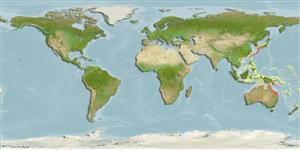Common names from other countries
>
Blenniiformes (Blennies) >
Blenniidae (Combtooth blennies) > Blenniinae
Etymology: Petroscirtes: Latin, petra, -ae = stone + Greek, skirteo = to jump.
Environment: milieu / climate zone / depth range / distribution range
экология
морской; солоноватоводный донно-пелагический; пределы глубины 1 - 10 m (Ref. 86942). Subtropical
Western Pacific: Queensland, New South Wales, Lord Howe Island, Australia and New Caledonia.
Size / Вес / Возраст
Maturity: Lm ? range ? - ? cm
Max length : 13.0 cm TL самец/пол неопределен; (Ref. 2334)
Краткое описание
определительные ключи | морфология | морфометрия
колючие лучи спинного плавника (общее число) : 11; членистые (мягкие) лучи спинного плавника (общее число) : 19 - 20; колючие лучи анального плавника: 2; членистые (мягкие) лучи анального плавника: 18 - 20. Jaw teeth incisiform, rigid, close-set, increasing with age; large, curved canine tooth on each side at posterior of lower jaw, and smaller canine on each side at posterior of upper jaw (similar dentition shared within genera); lower end of gill opening above level of pectoral-fin base (also a shared character within genera); small unbranched cirrus on each side of chin; with or without small supraorbital and nuchal cirri; body depth at anal-fin origin 4.5-7.0 SL; males with elongated second dorsal spine; unnotched dorsal fin; caudal fin interradial membranes slightly incised, notably in males; ground color variable with habitat, gray, brown, or green, with 6 large, uneven dark blotches on upper side and numerous white dots and dashes and, ventrally, dark dots. Anal soft rays rarely 18; pectoral soft rays typically 14; segmented caudal rays 1, unbranched (Ref. 54980).
Adults hide in seagrasses, seaweeds, or empty mollusk shells. Oviparous (Ref. 205). Mature females lay eggs on the inner surface of dead bivalve shells which are guarded by the male (Ref. 2334). Larvae are planktonic, often found in shallow, coastal waters (Ref. 94114).
Life cycle and mating behavior
Maturities | размножение | Spawnings | Egg(s) | Fecundities | личинки
Oviparous, distinct pairing (Ref. 205).
Randall, J.E., G.R. Allen and R.C. Steene, 1990. Fishes of the Great Barrier Reef and Coral Sea. University of Hawaii Press, Honolulu, Hawaii. 506 p. (Ref. 2334)
Статус Красного Списка МСОП (Ref. 130435)
CITES (Ref. 128078)
Not Evaluated
Угроза для людей
Harmless
Использование человеком
дополнительная информация
инструменты
Специальные отчеты
Скачать в формате XML
ресурсы в Интернет
Estimates based on models
Preferred temperature (Ref.
115969): 21.2 - 28, mean 26 (based on 599 cells).
Phylogenetic diversity index (Ref.
82804): PD
50 = 0.5005 [Uniqueness, from 0.5 = low to 2.0 = high].
Bayesian length-weight: a=0.00562 (0.00258 - 0.01228), b=3.06 (2.87 - 3.25), in cm Total Length, based on LWR estimates for this (Sub)family-body shape (Ref.
93245).
Trophic level (Ref.
69278): 2.1 ±0.2 se; based on size and trophs of closest relatives
устойчивость к внешним воздействиям (Ref.
120179): высокий, минимальное время удвоения популяции до 15 месяцев (Preliminary K or Fecundity.).
Fishing Vulnerability (Ref.
59153): Low vulnerability (10 of 100).
